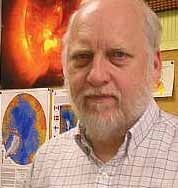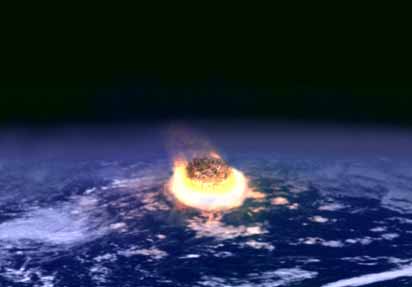|

by Mark Peplow
June 2, 2006
from
K8Science Website
Evidence of a cataclysmic meteorite impact has been unearthed in
Antarctica, according to researchers who say the collision could
possibly explain the greatest mass extinction ever seen on our
planet. But scientists contacted by
news@nature.com say they are
skeptical, as no signs of such an enormous impact have been found in
other, well-studied areas of Antarctica.
The first sign of this possible impact was spotted by NASA's
GRACE satellites, a pair of orbiting probes that sense slight
variations in the Earth's gravity field. They revealed a
320-kilometre-wide plug of dense mantle material more than 1.6
kilometers beneath the East Antarctic ice sheet in an area known as
Wilkes Land.
This mass concentration, or 'mascon', can be caused by the
upwelling of denser material from the Earth's mantle after a massive
impact.
"If I saw this mascon signal
on the Moon, I'd expect to see a crater around it," says
Ralph von Frese, a geophysicist at Ohio State University,
Columbus, who led the team that made the find.
When they looked at airborne radar
images of the area, they found what they say looks like a crater — a
circular ridge some 500 kilometers wide running around the mascon.
"It could be the biggest impact ever
found on Earth," says von Frese.
Incoming!
"It's possible, but it's not the
interpretation that would top your list," says Ian Dalziel,
a geologist at the University of Texas at Austin.
The region of dense rock is certainly
circular, he says, but it could easily be volcanic rock that had
welled up during normal geological activity:
"You can find a lot of gravity
anomalies like this."
The roughly circular feature thought to
be the rim of the crater may just be part of the normal variation in
terrain in the area, he adds.
If an incoming asteroid did gouge out the hole it must have been up
to 50 kilometers across, says von Frese. That's four or five times
larger than the object thought to have created the Chicxulub crater
on the Yucatan peninsula in Mexico, which was probably responsible
for wiping out the dinosaurs some 65 million years ago.
But that's peanuts compared with the Permian-Triassic extinction,
which destroyed more than three-quarters of all species on Earth
about 250 million years ago. The cause of this mass extinction is
still hotly debated by scientists.
Most think that the extinction started when a vast volcanic eruption
released a flood of lava to create the Siberian Traps — an area of
basalt that covers an area larger than Europe.
"They represent the biggest volcanic
event of all time, and coincide precisely with the extinction,"
says Paul Wignall, a palaeontologist at the University of
Leeds, UK, who studies mass-extinction events.
Such an eruption would have belched huge
amounts of gas, including sulphur dioxide and carbon dioxide, into
the atmosphere, causing acid rain and greenhouse warming.
Other scientists have argued that a massive impact, like that at
Chicxulub, could be responsible instead (see 'Comet
impact theory faces repeat analysis').
"But nobody's been convinced of
that," says Wignall.
Von Frese notes that the explanations
aren't mutually exclusive: the shockwaves from a huge impact could
have travelled through the planet to trigger the eruptions in
Siberia, delivering a devastating combination of disasters.
Hot topic
Von Frese presented the discovery at an American Geophysical
Union meeting in Baltimore, Maryland in late May. He admits that
it was greeted with "a lot of skepticism", largely because there's
no direct evidence that the feature is 250 million years old.
An impact of that size should also have melted and twisted nearby
rock. Yet rocks in the Transantarctic Mountains of the same
age show no evidence of the collision, says Jane Francis, a
geologist also at the University of Leeds.
"That sequence has been worked on
before, and no one has found evidence to support a massive
impact like this," she says.
Wignall says that few scientists will be
convinced by the hypothesis until the team can precisely date their
crater directly, and find rocks there that have been altered by the
searing heat of the explosion.
"Then we'll all sit up and take
notice," he says.
Too much ice covers the putative crater
for a drilling expedition.
But Von Frese hopes to make a research
trip to Antarctica to look for rocks at the base of the ice sheet
along the continent's coast that could attest to an impact.
BIG BANG IN ANTARCTICA
KILLER CRATER FOUND UNDER ICE
by Pam Frost Gorder
from
ResearchNews Website
|
Ancient mega-catastrophe
paved way for the dinosaurs, spawned Australian
continent
NSF and NASA funded this
work. Collaborators included Stuart Wells and Orlando
Hernandez, graduate students in geological sciences at
Ohio State; Luis Gaya-Piqué and Hyung Rae Kim, both of
NASA's Goddard Space Flight Center; Alexander Golynsky
of the All-Russia Research Institute for Geology and
Mineral Resources of the World Ocean;
and Jeong Woo Kim and Jong
Sun Hwang, both of Sejong University in Korea. |
COLUMBUS, Ohio -- Planetary scientists have found evidence of a
meteor impact much larger and earlier than the one that killed the
dinosaurs -- an impact that they believe caused the biggest mass
extinction in Earth's history.
The 300-mile-wide crater lies hidden more than a mile beneath the
East Antarctic Ice Sheet. And the
gravity measurements that reveal its existence suggest that it could
date back about 250 million years -- the time of the
Permian-Triassic extinction, when
almost all animal life on Earth died out.

Ralph von Frese
Its size and location - in the
Wilkes Land region of East
Antarctica, south of Australia - also suggest that it could have
begun the breakup of the
Gondwana supercontinent by creating
the tectonic rift that pushed Australia northward.
Scientists believe that the Permian-Triassic extinction paved the
way for the dinosaurs to rise to prominence. The Wilkes Land crater
is more than twice the size of the
Chicxulub crater in the Yucatan
peninsula, which marks the impact that may have ultimately killed
the dinosaurs 65 million years ago.
The Chicxulub meteor is thought
to have been 6 miles wide, while the Wilkes Land meteor could have
been up to 30 miles wide - four or five times wider.
"This Wilkes Land impact is much
bigger than the impact that killed the dinosaurs, and probably
would have caused catastrophic damage at the time," said
Ralph von Frese, a professor of geological sciences at Ohio
State University.
He and Laramie Potts, a
postdoctoral researcher in geological sciences, led the team that
discovered the crater. They collaborated with other Ohio State and
NASA scientists, as well as international partners from Russia and
Korea.
They reported their preliminary results
in a recent poster session at the American Geophysical Union
Joint Assembly meeting in Baltimore.

The scientists used gravity fluctuations
measured by
NASA's GRACE satellites to peer
beneath Antarctica's icy surface, and found a 200-mile-wide plug of
mantle material - a mass concentration, or "mascon" in geological
parlance - that had risen up into the Earth's crust.
Mascons are the planetary equivalent of a bump on the head.
They form where large objects slam into a planet's surface. Upon
impact, the denser mantle layer bounces up into the overlying crust,
which holds it in place beneath the crater.
When the scientists overlaid their gravity image with airborne radar
images of the ground beneath the ice, they found the mascon
perfectly centered inside a circular ridge some 300 miles wide - a
crater easily large enough to hold the state of Ohio. Taken alone,
the ridge structure wouldn't prove anything. But to von Frese, the
addition of the mascon means "impact."
Years of studying similar impacts on the
moon have honed his ability to find them.
"If I saw this same mascon
signal on the moon, I'd expect to see a crater around it," he
said. "And when we looked at the ice-probing airborne radar,
there it was."
"There are at least 20 impact craters this size or larger on the
moon, so it is not surprising to find one here," he continued.
"The active geology of the Earth likely scrubbed its surface
clean of many more."
He and Potts admitted that such signals
are open to interpretation. Even with radar and gravity
measurements, scientists are only just beginning to understand
what's happening inside the planet. Still, von Frese said that the
circumstances of the radar and mascon signals support their
interpretation.
"We compared two completely
different data sets taken under different conditions, and they
matched up," he said.
To estimate when the impact took place,
the scientists took a clue from the fact that the mascon is
still visible.
"On the moon, you can look at
craters, and the mascons are still there," von Frese said. "But
on Earth, it's unusual to find mascons, because the planet is
geologically active. The interior eventually recovers and the
mascon goes away."
He cited the very large and much older
Vredefort crater in South Africa that must have once had a mascon,
but no evidence of it can be seen now.
"Based on what we know about the
geologic history of the region, this Wilkes Land mascon formed
recently by geologic standards -- probably about 250 million
years ago," he said. "In another half a billion years, the
Wilkes Land mascon will probably disappear, too."
Approximately 100 million years ago,
Australia split from the ancient Gondwana supercontinent and
began drifting north, pushed away by the expansion of a rift valley
into the eastern Indian Ocean. The rift cuts directly through the
crater, so the impact may have helped the rift to form, von Frese
said.
But the more immediate effects of the impact would have devastated
life on Earth.
"All the environmental changes that
would have resulted from the impact would have created a highly
caustic environment that was really hard to endure. So it makes
sense that a lot of life went extinct at that time," he said.
He and Potts would like to go to
Antarctica to confirm the finding. The best evidence would come from
the rocks within the crater. Since the cost of drilling through more
than a mile of ice to reach these rocks directly is prohibitive,
they want to hunt for them at the base of the ice along the coast
where the ice streams are pushing scoured rock into the sea.
Airborne gravity and magnetic surveys
would also be very useful for testing their interpretation of the
satellite data, they said.
|


